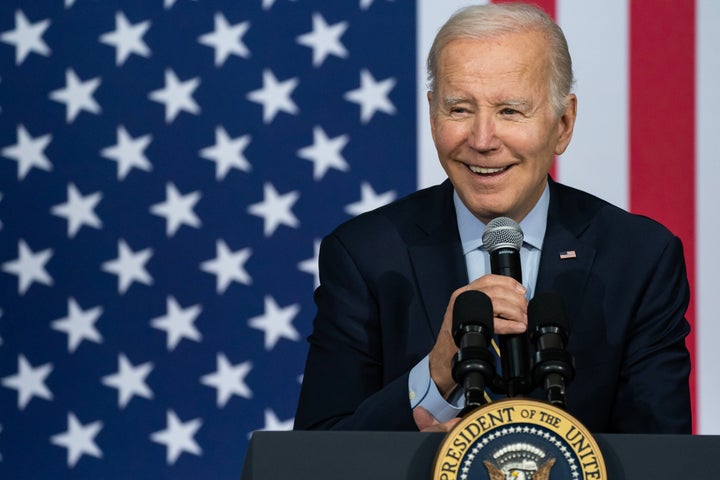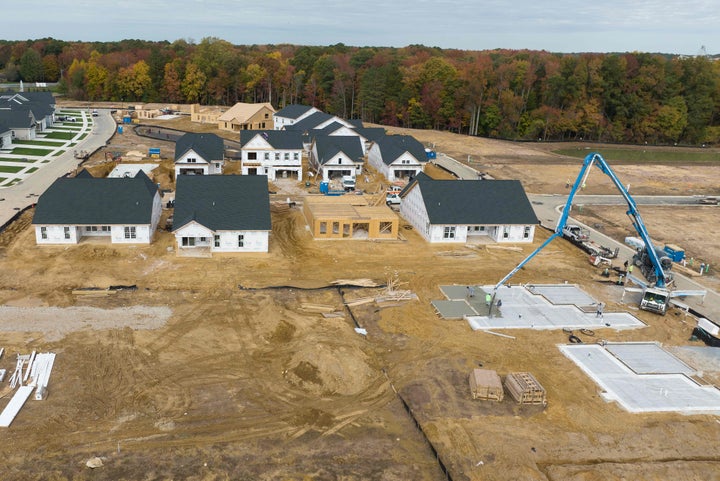
The Biden administration plans to require new homes to be constructed to the nation’s greenest, most energy-efficient building codes to qualify for the federal loans that finance more than one-sixth of new houses sold in the United States.
The rule proposed Thursday would affect at least 168,000 new homes per year, 151,000 of which would be new single-family or low-rise multifamily units. Today, those units must be built to 2009 energy codes to be eligible for loans from the Department of Housing and Urban Development’s Federal Housing Administration or from the Department of Agriculture. The proposal would set the most recently written code, which came out in 2021, as the new baseline.
Fewer homes would be impacted by the new proposal if more states mandate the latest energy codes on their own, as several already have and 20 more are considering doing.
Federal researchers estimate that the 2021 energy codes would save 35% more energy than the currently required 2009 standard and nearly 9% more than the last version of the codes released in 2018. Adopting the 2021 code will save homeowners and renters between $972 million and $1.5 billion over time, and save ratepayers approximately $74 million per year, according to HUD’s calculations.
“We’re now a big step closer to ensuring that builders of millions of new homes don’t leave residents with uncomfortable drafts and steep utility bills,” said Lowell Ungar, the federal policy director at the American Council for an Energy-Efficient Economy, or ACEEE, an advocacy group. “This step is way overdue, and now we want to see them act with urgency to finalize it. The longer it takes, the more homes are built that will need to be retrofitted later at higher cost.”
The U.S. has no nationwide building code. The model codes used in all 50 states are written and updated every three years by the International Code Council, a private consortium of local governments and industry groups. Rules for adopting the latest codes vary by state and city. While Idaho hasn’t updated its code beyond the standards designed nearly two decades ago, Illinois by law implements the latest version of the energy codes within a year of their release.
Eligibility requirements for loans may be the closest thing to a national building code.
Congress passed a law in 2007 ordering federal agencies to either write their own building codes — which has not yet been seriously attempted — or routinely adopt the latest model codes. The ICC, as it’s known, has updated its energy codes five times since, but regulators have followed the statute just once: In 2015 when the Obama administration hiked the requirement for HUD’s FHA loans to the 2009 code.
The Biden administration said it would complete the initial steps to codify the latest energy codes by the end of 2021. Yet, as HuffPost previously reported, the White House only cleared that first hurdle in late March, in apparent violation of a law that previous administrations had also flouted.
The announcement came with the news that HUD would open more than $830 million to applicants seeking money to add new insulation, electric appliances, or water heaters to make multifamily housing more efficient and resilient to climate change. The first-of-its-kind program could also issue up to $4 billion in loans.

The funding comes from the Inflation Reduction Act, President Joe Biden’s signature climate-spending law, which also includes hundreds of millions of dollars to help states adopt the latest energy codes.
Critics of the tougher efficiency rules, such as the National Association of Home Builders, say that stuffing homes with enough insulation and circuitry to meet the latest standards raises prices at a time when few metropolitan areas have enough affordable housing.
But HUD’s analysis, based on a standard price elasticity of demand model, found that an average construction cost increase of about 2% would, in the worst-case scenario, reduce the production of new homes that qualify for federal housing loans by 1.5%.
While the average homeowner or developer building a new single-family house to 2021 standards may pay about $5,500 more per unit compared to homes built to 2009 codes, the annual energy savings would still be $500 more per year than the cost of servicing that amount of debt each year of a mortgage, according to the HUD analysis.
The ACEEE said the efficiency measures more than pay for themselves in thousands of dollars of savings on heating and electric bills, particularly when energy prices swing with the latest political crisis or climate disaster.
The advocacy group’s 2020 survey found that drafty homes with poor wiring cost median low-income households 8.1% of their income in energy costs, more than double what the median U.S. household spends on utilities.
Codifying the most recent energy codes, which came into effect in 2021, into federal loans would come as something of a rebuke of the ICC itself.

That same year, the council — which has long been accused of kowtowing to the most powerful industry groups in its membership — proposed revamping the entire process for writing the next round of energy codes.
Previously, the ICC gave governments the final say over all its building codes, allowing the Leslie Knope-types tasked with enforcing the rules to vote on what made it into the model code.
In 2019, when the ICC convened to write the most recent codes, state and local officials voted to approve the most ambitious code in decades, hiking efficiency by as much as 14% after years of paltry 1% increases over the previous few code cycles. Infuriated industry groups successfully lobbied the ICC’s appeals board to strike key rules requiring all new buildings to have circuitry for electric appliances and car chargers.
In 2021, against the Biden administration’s protests, the ICC took the additional step of eliminating all future votes on energy codes. While governments still had the final say over the codes for plumbing or swimming pools, the energy codes would come from committees on which industry representatives would have representation equal to elected officials. The next codes, set to come out in 2024, are being written under that new process. As expected, the fossil fuel industry already appears to be wielding undue influence.
Neither the National Association of Home Builders nor the American Gas Association — which led the charge to roll back provisions of the ICC’s 2021 energy code — responded to requests for comment Thursday afternoon.
Another trade group, the American Public Gas Association, said Friday in an emailed statement that it was “still evaluating the proposed determination and its implications” but “looks forward to engaging in the public comment period.”
The APGA, which represents municipally owned gas distributors, said it was “disappointed” that the retrofit program HUD announced this week “appears to favor the replacement of gas-fired appliances with electric appliances.”
Insisting that new electric appliances might generate more emissions from power plants than the gas stoves and heaters they replaced, the group said, “Moving forward, we encourage HUD to maintain fuel neutrality in all policy decisions and regulations.”
Electric appliances tend to be more efficient than fuel ones, though industry groups opposed to electrification have frequently pointed to the coal- and gas-fired power plants that still make up 60% of the U.S. grid. But that, too, looks poised to change.
Thursday’s announcement came within hours of the Environmental Protection Agency releasing the nation’s first-ever regulation to cut greenhouse gases from power plants, the second-largest overall source of U.S. emissions.
This article has been updated to include a comment from the American Public Gas Association.
